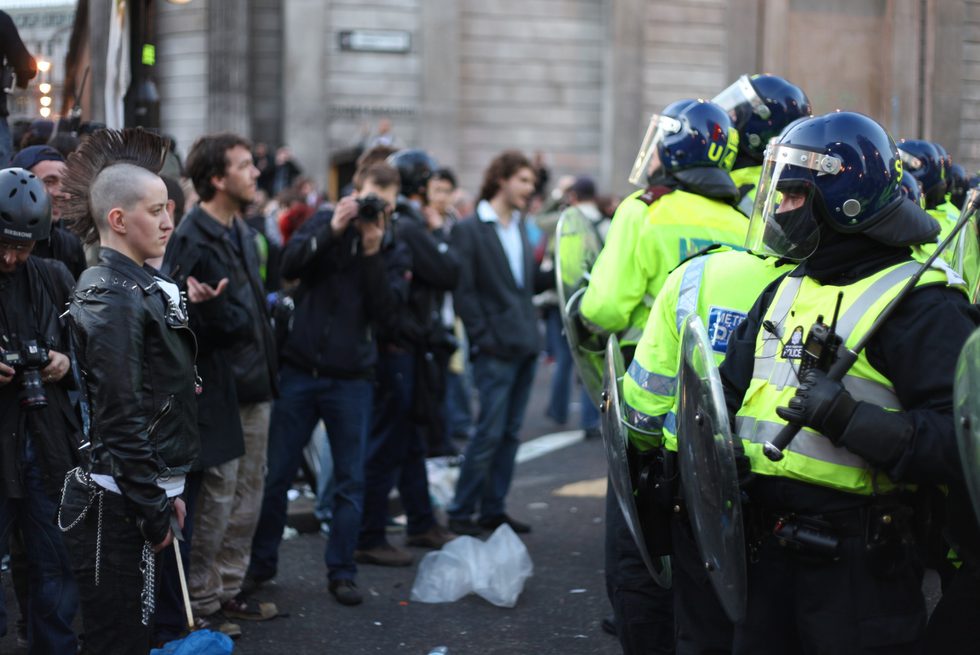Activism: Translation
From the Series: Activism
From the Series: Activism

The concept of translation can trigger an endless list of crucial discussions in the context of activism. Translating theory into practice, translating long-term objectives into short-term actions, or even translating anger and hate into positive forces. There is one specific instance of translation, however, that has always interested me the most: the translation of political objectives into the language of art activism.
My current research interest lies in the intersection between activism and performance, be it satirical protests such as those by the Billionaires for Bush (Haugerud, this series), solemn performances by groups like Liberate Tate, or embodied acts of radical singing by choirs such as Shell Out Sounds and Reverend Billy and the Stop Shopping Gospel Choir. In any case, the practice of activism entails one major process of translation: translating targets and objectives into action. But how is this translation different in the context of art activism, when the action in place involves harmonies, costumes or a script?
Beyond the vast potential for communication, pleasure, and collectivity that art activism offers (Holmes 2009, Verson 2007), I have always been fascinated by the ambiguous nature of this practice: not quite art, not quite activism. Perhaps both? This ambiguity means that the processes behind an artistic-political action incorporate elements of art making on the one hand, and campaigning or direct action on the other. In this context, there is usually a negotiation between the artistic objectives and formal aspects of a performance, and the direct political or social goal around which the performance functions. This negotiation will determine the translation of objectives into actions, and might include issues such as open participation vs. professionalized performances, the consideration of practical and technical performance issues, and the translation of political messages into symbols, poetry, and body language: exchanging marches, placards and speeches for harmonies, scripts and gestures.
Due to its ambiguous character, art activism poses specific challenges not only for activists planning actions that seek to fulfill both strategic and aesthetic goals, but also for scholars attempting to construct a theory of artistic-political practice. The gap between the theoretical worlds and languages of art history and aesthetics on the one hand, and the social sciences on the other, means that most studies on this topic take one of two approaches. The first looks at art activism as a ‘politicized’ artistic practice, and overlooks the vast amount of volumes on social movement theory—from McAdam, Tarrow and Tilly (2001) to Melucci (1996). The second looks at art activism as an aestheticized form of protest, considering the artistic quality of these types of actions as an interesting twist, but failing to acknowledge that this artistic element is not superficial, but rather at the basis of the processes and dynamics behind an action, thus making it inherently different from other forms of protest.
In response to this issue, I argue for an interdisciplinary research method that goes beyond these two approaches, and looks at art activism as a distinct practice; as something else. This, however, poses certain challenges: what terminology should we use, assuming a great amount of literature on art activism or ‘activist art’ isn’t really about activism? And most importantly, up to what point can we rely on existing categories and frameworks provided by aesthetics and social movement theory, when these do not contemplate the exceptional character of actions that are neither art nor activism (or that are both at the same time)? For instance, how are issues of participation (Bishop 2012) to be approached when an action is both an artistic performance and part of a social movement?
Perhaps what is needed is not a translation from one discipline to
the other, but rather the building of a joint specific framework and
language that can provide a more comprehensive analysis of art activism.
A challenging task for sure, considering that the power of art activism
lies largely in its ability to surprise and confuse audiences and
authority figures, and to skillfully elude categorizations.
Bishop, Claire. 2012. Artificial Hells. London: Verso
Holmes, Brian. 2009. Escape the Overcode: Activist Art in the Control Society. Eindhoven: Van Abbemuseum.
McAdam, Doug, Sidney Tarrow and Charlese Tilly. 2001. Dynamics of Contention. New York: Cambridge University Press.
Melucci, Alberto. 1996. Challenging Codes: Collective Action in the Information Age. Cambridge: Cambridge University Press.
Verson, Jenifer. 2007. "Why We Need Cultural Activism." In Do it Yourself: A Handbook for Changing our World, edited by The Trapese Collective, 171-186. London: Pluto.